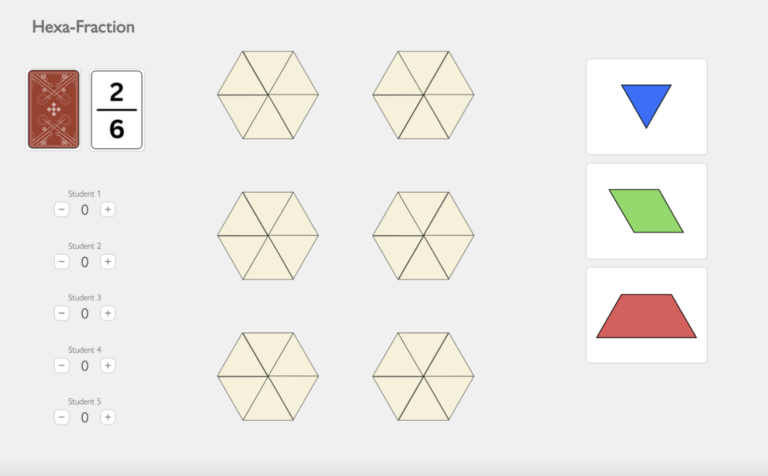Hexa Fraction
Junior (Age 9 – 12)
Curriculum Goal
Junior: Number Sense
- Represent fractions from halves to tenths using drawings, tools, and standard fractional notation, and explain the meanings of the denominator and the numerator.
Fraction Goals:
- Fraction Equivalence
- Fraction Magnitude
Context
- Children should be familiar with different area models for representing fractions
Materials
- In-person version:
- Game board with outlines of 6 hexagons (Appendix A)
- Pattern blocks (Trapezoid, Rhombus and Triangle only)
- Blank paper to tally points
- Fraction cards (Appendix B)
- Online version:
- Game file (Appendix C) – Playingcards.io upload instructions
Lesson
- Children practice representing fractions and identifying equivalent fractions.
- The objective of the game is for the children to “claim” the most hexagons on the board by filling them in with pattern blocks. If a child fills in a hexagon on their turn, they “claim” that hexagon and earn one point.
- Each child will keep track of their points by tallying them on a piece of paper.
- In the online version, each child is assigned a point counter on the game board with their name.
- Children take turns drawing one fraction card from the deck.
- Reuse the cards when all have been drawn. Consider printing more than one copy Appendix B to create a larger deck of cards.
- Once the child has drawn a card, they select one or more pattern blocks that represent the fraction on the card and place them in a hexagon(s).
- g., if a child draws the 1/2 card, they can use any combination of pattern blocks (i.e., 3 triangles; 1 parallelogram and 1 triangle; or 1 trapezoid) to fill in half of any of the hexagons.
- Children can also choose to divide their fraction amongst the hexagons.
- g., if a child draws 1/2, they can place three triangles in one hexagon OR place two triangles in one hexagon and one triangle in another hexagon, as 3 triangles make up half of a hexagon.
- The child to place the last piece in a hexagon “claims” that hexagon and earns one point.
- The game ends when all the hexagons are filled in. The child with the most points at the end of the round wins.


Look Fors
- Are the children able to match their fraction cards to the equivalent pattern blocks?
- Do the children use equivalent fractions to maximize their chances of claiming a hexagon?
- E.g., when a child draws a 1/2 fraction card, do they use three triangle pattern blocks and divide it up amongst the hexagons if this allows them to “claim” a hexagon versus using one trapezoid pattern block?
Share this lesson
Share on facebook
Share on twitter
Share on email
